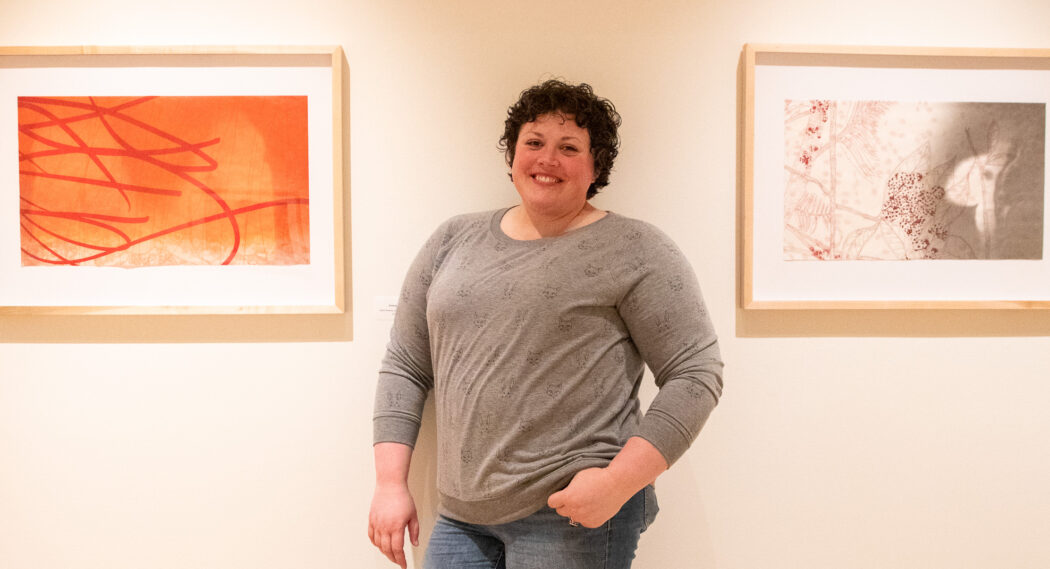Amanda Petersen “doesn’t quit”
Amanda Petersen, a master’s graduate at Utah State University, took an unexpected path through college.
Petersen began her master’s program in 2020. At the end of the 2022 spring semester, she was diagnosed with triple-negative breast cancer, which is the most aggressive form, Petersen said.
Not only was Petersen dealing with cancer, she was taking multiple classes a semester, all while teaching undergraduate classes and raising her children.
“I think that a lot of people would have postponed or left the program altogether,” Matt Petersen, Amanda’s husband, wrote in a text message.
Amanda didn’t take time off.
“I worked it out with the department so I could keep teaching,” Amanda said.
Amanda taught during all three semesters she was battling cancer. She would teach her classes at the beginning of the week, then do chemotherapy on Thursdays and recover during the weekend.
Amanda had five surgeries during her master’s program, including a mastectomy. The cancer is gone for now, but there’s a significant likelihood of it coming back in the first few years of remission.
“My life has been extended,” she said. “My mantra is, Today’s today.’ I can’t sit there and wonder all of the what-ifs. I need to live life now.”
Kathy Puzey, the department head of art and design at USU, wrote in an email Amanda is a hardworking and dedicated student. “She has faced hard challenges head on,” Puzey wrote.
After starting her undergraduate degree in art education, Amanda and her husband moved out of state for her husband’s graduate education. Upon moving back to Utah several years later, Amanda felt like she needed to finish her education because of her three kids.
“I want my kids to see how important education is,” she said.
Amanda got her bachelor’s degree in art education from Weber State University in 2020, after which she began a master of Fine Arts in the printmaking program at USU.
“Her work continued to develop because she was open to feedback and willing to take risks,” Puzey said. “Despite some big roadblocks, Amanda continued to work.”
Matt said it was difficult watching his wife go through chemotherapy.
“I don’t think that I can describe in words the experience that Amanda persevered through,” he wrote.
Matt wrote his wife maintained her sense of humor and “during chemotherapy often highlighted the fact that we were ‘bald buddies’ though we were both bald not by choice,” he added.
Before Amanda was diagnosed, she pondered defense mechanisms. Insects and reptiles have defense mechanisms like spines on their bodies and acids that warn other creatures to stay away.
Amanda’s art reflected this thinking. She screen printed objects that were useless, such as an umbrella with holes, a telephone without buttons and a butter knife with no blade.
Amanda had recently lost her dad, stepdad and uncle in a two-year span.
While she was processing the grief of losing family members, she thought human defense systems were useless. The grief cycle is something that never goes away and no one is spared from, she had said.
“Once I was diagnosed, I realized, oh, these defense mechanisms are important,” Amanda said.
Before her cancer diagnosis, Amanda kept her art palatable to her family, wondering if they would have a negative reaction.
However, after diagnosis and after her mastectomy, Amanda realized she wasn’t being vulnerable with herself. She wanted to control the narrative.
“When you get diagnosed with something like that, you don’t have a lot of control,” she said.
Amanda’s art changed as she utilized her new perspective.
“I was able to translate that into art. I never would have been that vulnerable before,” Amanda said.
During her childhood, Amanda as always involved in art and print. She job-shadowed her dad, who worked for a global print shop. Amanda did art in school and worked part-time print jobs. Before getting married, she did fine art framing at her dad’s company.
After she got married, she printed Braille for five years. Working with books or art has “always been my adult job,” Amanda said.
“Art-making is a part of Amanda,” Puzey said. “It is more than what she does. Being an artist is who she is.”
Printmaking has been a large part of Amanda’s college experience.
Combining art education with printmaking is important, Amanda said. “You can trace that back to Lascaux cave where people are putting handprints like they’re making their mark.”
Amanda said whether it’s was letterpress printing or relief carving or linoleum carving, “you’re removing material, and you have that magic of inking the plate up, running it through the press, and it goes through all of that pressure. And something amazing happens on the other side. You have that aha moment where you get to peel back the paper and all of a sudden, your progress is revealed,” she said.
Amanda likes the touching up that comes after. “You’re able to glean that from the beauty of the printmaking processes,” she said.
Amanda is proud of her accomplishments throughout her graduate degree. “As a collective whole, being able to have institutions that supported me while being a student, a mother, and then a cancer patient,” she said. Amanda said she wouldn’t have been able to complete the master’s without her support she received from her grad committee.
“Amanda is tenacious, very tenacious,” Matt said. “She doesn’t quit.”
Amanda is searching for job opportunities in the valley and elsewhere, looking for what is best for her and her family. “Ultimately, I would love to be teaching because that is what I love to do,” she said. “Looking for opportunities to share my love of art.”
You must be logged in to post a comment.


There are no comments
Add yours